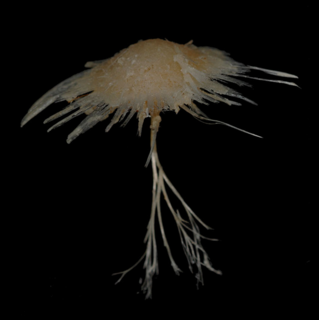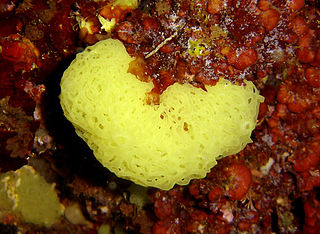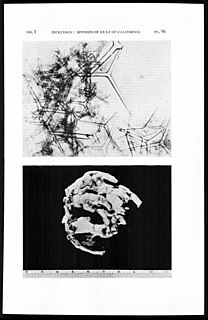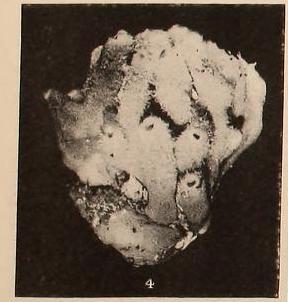
Cladorhiza is a genus of carnivorous sponges, comprising around 40 species found in oceans around the world. Cladorhiza is the type genus of the family Cladorhizidae.

Clathrina is a genus of calcareous sponge in the family Clathrinidae. Several species formerly in Clathrina were transferred to the newly erected genera Arturia, Ernstia, Borojevia, and Brattegardia in 2013. The name is derived from the Latin word "clathratus" meaning "latticed".

Polymastia is a genus of sea sponges containing about 30 species. These are small to large encrusting or dome-shaped sponges with a smooth surface having many teat-shaped projections (papillae). In areas of strong wave action, this genus does not grow the teat structures, but instead grows in a corrugated form.

Halichondria is a genus of sea sponges belonging to the family Halichondriidae. These are massive, amorphous sponges with clearly separated inner and outer skeletons consisting of bundles of spicules arranged in a seemingly random pattern.
Arturia dubia is a species of calcareous sponge in the genus Arturia from Australia. The species was first described as Leucosolenia dubia by Arthur Dendy in 1891. The name is derived from Dendy's uncertainty about the validity of the species, believing his specimens could, in fact, represent juvenile Leucosolenia cavata.
Leuconia is a genus of calcareous sponges in the family Baeriidae. It was described by English anatomist and zoologist Robert Edmond Grant in 1833.
Leucopsila is a genus of poriferans in the family Baeriidae. It contains one species, Leucopsila stylifera, which was originally described as Leuconia stylifera in 1870. The genus was described by Dendy & Row in 1913.
Homaxinella is a genus of sea sponges in the family Suberitidae. The type species is Homaxinella balfourensis.

Arthur Dendy was an English zoologist known for his work on marine sponges and the terrestrial invertebrates of Victoria, Australia, notably including the "living fossil" Peripatus. He was in turn professor of zoology in New Zealand, in South Africa and finally at King's College London. He was a Fellow of the Royal Society.

Arturia is a genus of calcareous sponge in the family Clathrinidae which contains 14 species. It is named after Arthur Dendy, a prominent researcher of calcareous sponges. It was renamed Arturia in 2017 because the name Arthuria was already assigned to a genus of molluscs.
Cladorhiza inversa is a species of sponge in the taxonomic class Demospongiae. The body of the sponge consists of a spicule and fibers and is water absorbent.
Baeriidae is a family of calcareous sponges in the class Calcarea. It was named by Borojevic, Boury-Esnault, and Vacelet in 2000. The type genus is BaeriaMiklucho-Maclay, 1870, by original designation, though Baeria is now considered a junior synonym of LeuconiaGrant, 1833.
Ciocalypta is a genus of sea sponges belonging to the family Halichondriidae.

Soleneiscus is a genus of calcareous sponges in the family Dendyidae.
Ascaltis is a genus of sponges in the family Leucascidae, first described in 1872 by Ernst Haeckel.
Ascaltis grisea is a species of sea sponge in the family Leucascidae, first described as Leucosolenia grisea by Arthur Dendy in 1891. It is known only from its type locality on the Houtman Albrolhos archipeligo in Western Australia. It is a marine sessile filter-feeder.

Leucetta is a genus of sponges in the family Leucettidae, which was first described in 1872 by Ernst Haeckel. The type species is Leucetta primigenia Haeckel, 1872 by subsequent designation.
Vosmaeropsis complanatispinifera is a species of calcareous sponge in the family Heteropiidae, and was first described in 2015 by Cavalcanti, Bastos & Lanna. It is found off the Brazilian coast.
Vosmaeropsis recruta is a species of calcareous sponge in the family Heteropiidae, and was first described in 2015 by Cavalcanti, Bastos & Lanna. It is found off the Brazilian coast.

Vosmaeropsis mackinnoni is a species of calcareous sponge in the family Heteropiidae, and was first described in 1924 by Arthur Dendy and Leslie M. Frederick. It is known only from its type locality in the Abrolhos Islands, in Western Australia.









